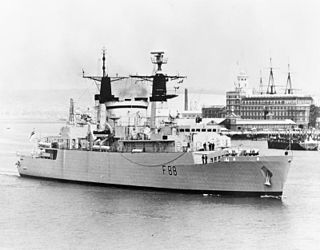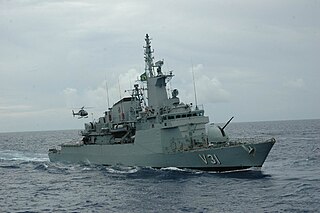
HMS Broadsword was the lead ship and first Batch 1 unit of the Type 22 frigates of the Royal Navy.

USS Hermitage (LSD-34) was a Thomaston-class dock landing ship of the United States Navy. She was named for The Hermitage, President Andrew Jackson's estate just outside Nashville, Tennessee.

Avibrás Indústria Aeroespacial, based in Jacareí, São José dos Campos, Brazil, is a diversified Brazilian company which designs, develops and manufactures defense products and services. Its range of products encompasses artillery and aircraft defense systems, rockets and missiles such as air-to-ground and surface-to-surface weapon systems, including artillery rocket systems; 70 mm air-to-ground systems and fiber optic multi-purpose guided missiles. It makes armoured vehicles as well. It also manufactures civilian transportation through a division called Tectran, telecommunications equipment, electronic industrial equipment (Powertronics), automotive painting and explosives.

Astros II is a self-propelled multiple rocket launcher produced in Brazil by the Avibras company. It features modular design and employs rockets with calibers ranging from 127 to 450 mm. It was developed on the basis of a Tectran VBT-2028 6×6 all-terrain vehicle for enhanced mobility based on Mercedes-Benz 2028 truck chassis while later versions use Tatra 815-7 chassis.

The MAA-1 Piranha is a short-range infrared homing missile and the first air-to-air missile developed by Brazil for its Air Force and Navy. It was designed to replace the AIM-9 Sidewinder missile in Brazilian service and has since been exported to Colombia, Indonesia and Pakistan.
The V3E A-Darter is a modern short-range infrared homing air-to-air missile, featuring countermeasures resistance with a 180-degree look angle and 120-degrees per second track rate, developed by South Africa's Denel Dynamics and Brazil's Mectron, Avibras and Opto Eletrônica. It will equip the South African Air Force's Saab JAS 39 Gripen C/D and BAE Hawk 120, and the Brazilian Air Force's A-1M AMX, Northrop F-5BR and Gripen E/F. It was expected to be in production before the end of 2015. As of November 2022, no combat capable missiles had been produced.
The MAX 1.2 AC, —previously known as MSS 1.2 AC— is a Brazilian anti-tank guided missile (ATGM). Operated by infantry or vehicles, the system consists of a reloadable launch tube, laser-guided missile and firing unit, as well as a simulator and testing equipment. It was developed out of Oto Melara's “Missile Anti-Carro della Fanteria”, which was rejected by the Italian Army. Brazilian involvement began in 1986 and it has since then been tested and redesigned by the Brazilian Army's research institutes and a series of Brazilian companies.

The Brazilian Naval Aviation is the air component of the Brazilian Navy, currently called Força Aeronaval. Most of its air structure is subordinated to the Naval Air Force Command, the military organization responsible for providing operational air support from Navy vessels, while four squadrons are subordinated to the Naval Districts, responsible for inland and coastal waters. ComForAerNav is headquartered at the Naval Air Base of São Pedro da Aldeia, where all aircraft fleet level maintenance is carried out and where the Aeronaval Instruction and Training Center is located, which forms its staff. Its pilots, all officers with one to three years of prior naval experience, fly its helicopters, airplanes and Remotely Piloted Aircraft as extensions of the ships' weaponry and sensors.

The CAMM is a family of surface-to-air missiles developed by MBDA UK for the United Kingdom. CAMM is derived from, and shares some common features and components with, the Advanced Short-Range Air-to-Air Missile (ASRAAM), but with updated electronics, a soft vertical launch system, and an active radar homing seeker. The CAMM family is in use by or on order for the armed forces of several countries.

FOG-MPM(fiber optics guided multiple purpose missile) is a missile built by the Brazilian company Avibras. Its range is about 60 km. The weight is about 34 kg. Its main use is as an anti-tank, anti-fortification and anti-helicopter missile. FOG-MPM is guided by optical fiber technology. The FOG-MPM is very flexible, can be launched from ground vehicles (Astros II MLRS), ships and helicopters, and is immune to electronic measures.

The AV-TM 300 Tactical Missile or MTC-300 is a Brazilian cruise missile developed by Avibras for the Astros II system. Nicknamed Matador ("killer"), it is projected to be a less expensive alternative to the American BGM-109 Tomahawk. The missile is equipped with a central computer that combines a Ring laser gyroscope, connected to an active GPS navigation device that uninterruptedly supplies positioning information for course correction. Apparently there also will be a naval version called X-300. The missile can use a single warhead of 200 to 500 kg high explosive or cluster munition warhead with 64 submunitions for anti-personnel or anti-tank targets.
The MAR-1 is an air-to-surface (ASM) and surface-to-surface (SSM) anti-radiation missile (ARM) with GPS/INS capability under development by Brazil's Mectron and the Aerospace Technology and Science Department of the Brazilian Air Force. It is designed to suppress enemy air defenses (SEAD) by targeting surveillance radars and fire-control radars.

Sistemas Integrados de Alto Teor Tecnológico (SIATT) is a Brazilian arms company founded in 2017 and headquartered in São Paulo. It primarily develops and manufactures precision-guided munitions. It supplies anti-ship, anti-tank missiles and training to the Brazilian Armed Forces.

EDGE Group is an Emirati advanced technology and defence conglomerate comprising 25 companies involved in military and civilian products, and technologies.

The Tamandaré class is a series of stealth frigates under construction for the Brazilian Navy since 2022, based on the MEKO family of warships. The project was developed by ThyssenKrupp Marine Systems in partnership with Embraer Defense and Security. As of 2024, four ships have been ordered, with other four planned as a second batch.
Torpedo Pesado NacionalTPNer also known as TP-1, is a Brazilian heavyweight anti-submarine warfare torpedo under development by the Brazilian defense company Mectron S.A. and the Brazilian Navy.

The Aerospace Operations Command is a joint command of the Brazilian Armed Forces in charge of planning, coordinating and conducting the employment of aerospace assets. Although part of the Brazilian Air Force's structure, it includes personnel from the Brazilian Army and Navy. COMAE is the central body in the Brazilian Aerospace Defense System and as such, is directly responsible for the aerospace defense of Brazilian territory and may control Air Force, Army and Navy units.

Jaceguai(V31) was the second ship of the Inhaúma-class corvette of the Brazilian Navy.
This list shows the past, present and future strategic re-equipment and modernization programs of the Brazilian Armed Forces that was based on the documents of the National Defense Strategy of 2008, and subsequent versions of the Defense White Paper that outline the major defense programs in Brazil from 2008 until 2040. To see active equipment of the three branches, see the following pages for the Army, Navy and the Air Force.
















